Morphology of Microchips in the Surface Finishing Process Utilizing Abrasive Films
Abstract
1. Introduction
2. Materials and Methods
2.1. Surface Analysis of Lapping Films before the Finishing Process
2.2. Surface Analysis of Lapping Films and Microchips after the Finishing Process
2.3. Surface Finishing Process
2.4. Surface Analysis after the Surface Smoothing Process
- Sp—surface peak height;
- Sv—surface valley depth;
- Sz—surface height;
- Sa—arithmetic mean height.
3. Results and Discussion
3.1. Studies of Lapping Films
3.2. Research on Microchips, Lapping Film Finishing Products
3.3. Analysis of Processed Surfaces Using Lapping Films
4. Summary and Conclusions
- SEM images of lapping films with different nominal grain sizes (9 µm, 12 µm, and 30 µm) revealed variations in the machined zones and tool surfaces after processing. The distinct characteristics of the lapping film surfaces at various grain sizes emphasized the influence of film grades on resulting surface morphology. Microchips resulting from the surface finishing process were observed to be significantly smaller than the abrasive grains on the tool surface.
- Wear zones around abrasive aggregates were observed on 12LF and 9LF films, indicating a potential weakening of cutting capabilities and the risk of damaging the machined surface. In contrast, the absence of wear zones on the 30LF film suggested a more efficient evacuation of microchips, contributing to a controlled finishing process. Tool wear, manifested as clogging around abrasive aggregates, resulted in short, densely arranged chips near the highest peaks.
- Analysis of tool surfaces indicated that abrasive grains were exposed from beneath a thin binder layer just before the micromachining process, emphasizing the importance of the initial cutting conditions.
- Unusual agglomerates formed among finishing products due to high temperatures and chip rolling, resulting in fused structures. This phenomenon highlighted the influence of temperature on chip behavior during the finishing process.
- Examination of microchips revealed a segmented structure with diverse shapes and thicknesses. The presence of extremely thin chips with a segmented structure indicated a connection with high material separation speed. The analysis of chip segment thickness allowed for the calculation of chip segmentation frequency, reaching megahertz levels.
- Surface roughness parameters (Sp, Sv, Sz, Sa) were used to assess the quality of machined surfaces after lapping film processing. The results showed a decrease in parameters after each film application, with the final operation eliminating machining traces from previous treatments. The study explored the relationship between material removal rate, chip width, and lapping film characteristics.
- Despite extensive examinations, no occurrence of spherical chips or microspheres was observed during lapping film processing. The absence of spherical chips was attributed to the controlled smoothing of the RG7 bronze alloy, indicating specific temperature conditions, where the processing temperature did not exceed the melting temperature of the material.
- The study revealed diverse chip structures based on electrocorundum grain shapes, cutting edges, and chip thicknesses. The presence of jagged edges, segmented chips, and variations in chip width and shape highlighted the complexity of chip formation.
Author Contributions
Funding
Institutional Review Board Statement
Informed Consent Statement
Data Availability Statement
Conflicts of Interest
References
- Shan, K.; Zhang, Y.; Lan, Y.; Jiang, K.; Xiao, G.; Li, B. Surface Roughness Prediction of Titanium Alloy during Abrasive Belt Grinding Based on an Improved Radial Basis Function (RBF) Neural Network. Materials 2023, 16, 7224. [Google Scholar] [CrossRef]
- Serpin, K.; Mezghani, S.; El Mansori, M. Multiscale assessment of structured coated abrasive grits in belt finishing process. Wear 2015, 332–333, 780–787. [Google Scholar] [CrossRef]
- Rech, J.; Kermouche, G.; Claudin, C.; Khellouki, A.; Grzesik, W. Modelling of the residual stresses induced by belt finishing on a AISI52100 hardened steel. Int. J. Mater. Form. 2008, 1, 567–570. [Google Scholar] [CrossRef]
- Wang, W.; Salvatore, F.; Rech, J.; Li, J. Comprehensive investigation on mechanisms of dry belt grinding on AISI52100 hardened steel. Tribol. Int. 2018, 121, 310–320. [Google Scholar] [CrossRef]
- Huang, X.; Guo, Y.; Guo, W.; Qi, B.; Ren, X.; Chai, Z.; Chen, X. Comprehensive investigations into the force and thermal characteristics of belt grinding Inconel 718 under constant normal forces. J. Manuf. Process. 2023, 99, 78–95. [Google Scholar] [CrossRef]
- Zhang, Y.; Xiao, G.; Zhou, K.; Zhu, B.; Gao, H.; Huang, Y. Two-Phase fatigue life prediction method based on scSE U-net algorithm for abrasive belt grinding of titanium alloy. J. Mater. Process. Technol. 2023, 319, 118075. [Google Scholar] [CrossRef]
- Liu, Y.; Song, S.; Zhang, Y.; Li, W.; Xiao, G. Prediction of surface roughness of abrasive belt grinding of superalloy material based on rlsom-rbf. Materials 2021, 14, 5701. [Google Scholar] [CrossRef] [PubMed]
- Chen, X.; Dai, Y.; Hu, H.; Tie, G.; Guan, C. Research on high precision and deterministic figuring for shaft parts based on abrasive belt polishing. Materials 2019, 12, 1389. [Google Scholar] [CrossRef]
- Mezghani, S.; El Mansori, M.; Zahouani, H. New criterion of grain size choice for optimal surface texture and tolerance in belt finishing production. Wear 2009, 266, 578–580. [Google Scholar] [CrossRef]
- Mezghani, S.; El Mansori, M.; Massaq, A.; Ghidossi, P. Correlation between surface topography and tribological mechanisms of the belt-finishing process using multiscale finishing process signature. Comptes Rendus Mécanique 2008, 336, 794–799. [Google Scholar] [CrossRef]
- He, Y.; Xiao, G.; Li, W.; Huang, Y. Residual stress of a TC17 titanium alloy after belt grinding and its impact on the fatigue life. Materials 2018, 11, 2218. [Google Scholar] [CrossRef]
- Zhang, B.; Wu, S.; Wang, D.; Yang, S.; Jiang, F.; Li, C. A review of surface quality control technology for robotic abrasive belt grinding of aero-engine blades. Meas. J. Int. Meas. Confed. 2023, 220, 113381. [Google Scholar] [CrossRef]
- Min, K.; Ni, F.; Liu, H. Robotic abrasive belt grinding of complex curved blades based on a novel force control architecture integrating smooth trajectories. J. Manuf. Process. 2023, 107, 447–458. [Google Scholar] [CrossRef]
- Khellouki, A.; Rech, J.; Zahouani, H. The effect of lubrication conditions on belt finishing. Int. J. Mach. Tools Manuf. 2010, 50, 917–921. [Google Scholar] [CrossRef]
- Mezghani, S.; El Mansori, M. Abrasiveness properties assessment of coated abrasives for precision belt grinding. Surf. Coat. Technol. 2008, 203, 786–789. [Google Scholar] [CrossRef]
- Serpin, K.; Mezghani, S.; El Mansori, M. Wear study of structured coated belts in advanced abrasive belt finishing. Surf. Coat. Technol. 2015, 284, 365–376. [Google Scholar] [CrossRef]
- Zou, L.; Liu, X.; Huang, Y.; Fei, Y. A numerical approach to predict the machined surface topography of abrasive belt flexible grinding. Int. J. Adv. Manuf. Technol. 2019, 104, 2961–2970. [Google Scholar] [CrossRef]
- Kacalak, W.; Tandecka, K.; Mathia, T.G. A method and new parameters for assessing the active surface topography of diamond abrasive films. J. Mach. Eng. 2016, 16, 95–108. [Google Scholar]
- Sadeghifar, M.; Sedaghati, R.; Jomaa, W.; Songmene, V. A comprehensive review of finite element modeling of orthogonal machining process: Chip formation and surface integrity predictions. Int. J. Adv. Manuf. Technol. 2018, 96, 3747–3791. [Google Scholar] [CrossRef]
- Hamdi, A.; Merghache, S.M.; Fernini, B.; Aliouane, T. Influence of polymer contacting rollers on surface texture finish in the belt grinding process. Int. J. Adv. Manuf. Technol. 2021, 113, 1377–1388. [Google Scholar] [CrossRef]
- Perçin, M.; Aslantas, K.; Ucun, I.; Kaynak, Y.; Çicek, A. Micro-drilling of Ti-6Al-4V alloy: The effects of cooling/lubricating. Precis. Eng. 2016, 45, 450–462. [Google Scholar] [CrossRef]
- Yip, W.S.; To, S. Reduction of Minimum Cutting Thickness of Titanium Alloys in Micro Cutting by a Magnetic Field Assistance. IEEE Access 2019, 7, 152034–152041. [Google Scholar] [CrossRef]
- Liu, D.; Ni, C.; Wang, Y.; Zhu, L. Review of serrated chip characteristics and formation mechanism from conventional to additively manufactured titanium alloys. J. Alloys Compd. 2024, 970, 172573. [Google Scholar] [CrossRef]
- Barry, J.; Byrne, G.; Lennon, D. Observations on chip formation and acoustic emission in machining Ti-6Al-4V alloy. Int. J. Mach. Tools Manuf. 2001, 41, 1055–1070. [Google Scholar] [CrossRef]
- Sutter, G.; List, G. Very high speed cutting of Ti-6Al-4V titanium alloy—Change in morphology and mechanism of chip formation. Int. J. Mach. Tools Manuf. 2013, 66, 37–43. [Google Scholar] [CrossRef]
- Liu, H.; Zhang, J.; Xu, X.; Zhao, W. Experimental study on fracture mechanism transformation in chip segmentation of Ti-6Al-4V alloys during high-speed machining. J. Mater. Process. Technol. 2018, 257, 132–140. [Google Scholar] [CrossRef]
- Mathia, T.G.; Pawlus, P.; Wieczorowski, M. Recent trends in surface metrology. Wear 2011, 271, 494–508. [Google Scholar] [CrossRef]
- Kubiak, K.J.; Wilson, M.C.T.; Mathia, T.G.; Carval, P. Wettability versus roughness of engineering surfaces. Wear 2011, 271, 523–528. [Google Scholar] [CrossRef]
- ISO 25178-2:2021; Geometrical Product Specifications (GPS): Surface Texture: Areal—Part 2: Terms, Definitions and Surface Texture Parameters. ISO: Geneva, Switzerland, 2021.
- ISO/DIS 16610-45; Geometrical Product Specifications (GPS): Filtration—Part 45: Morphological Profile Filters: Segmentation. ISO: Geneva, Switzerland, 2015.
- Szada-Borzyszkowska, M.; Kacalak, W.; Banaszek, K.; Borkowski, P.J.; Szada-Borzyszkowski, W. Analysis of the pulsating properties of a high-pressure water jet generated in a self-excited head for erosion processing. Arch. Civ. Mech. Eng. 2023, 23, 236. [Google Scholar] [CrossRef]
- Ye, G. The formation mechanism of discontinuously segmented chip in high-speed cutting of Ti-6Al-4V. Int. J. Adv. Manuf. Technol. 2023, 130, 1477–1493. [Google Scholar] [CrossRef]
- Kacalak, W.; Rypina, Ł.; Tandecka, K. Evaluation of Micromachining Processes Using Data in the Format and Geometric Characteristics of Micro-Chips. J. Mach. Eng. 2015, 15, 59–68. [Google Scholar]
- Kouadri, S.; Necib, K.; Atlati, S.; Haddag, B.; Nouari, M. Quantification of the chip segmentation in metal machining: Application to machining the aeronautical aluminium alloy AA2024-T351 with cemented carbide tools WC-Co. Int. J. Mach. Tools Manuf. 2013, 64, 102–113. [Google Scholar] [CrossRef]
- Kacalak, W.; Rypina, Ł.; Królikowski, T. Influence of analysis of features geometrical abrasive grains stress, strain and displacement of material in zone microgrinding. Mechanik 2015, 8–9, 711/139–711/145. [Google Scholar] [CrossRef][Green Version]
- Devotta, A.; Beno, T.; Siriki, R.; Löf, R.; Eynian, M. Finite Element Modeling and Validation of Chip Segmentation in Machining of AISI 1045 Steel. Procedia CIRP 2017, 58, 499–504. [Google Scholar] [CrossRef]
- Zanger, F.; Kacaras, A.; Bächle, M.; Schwabe, M.; León, F.P.; Schulze, V. FEM simulation and acoustic emission based characterization of chip segmentation frequency in machining of Ti-6Al-4V. Procedia CIRP 2018, 72, 1421–1426. [Google Scholar] [CrossRef]
- Sahoo, P.; Banerjee, N.; Singh, R.K. Modeling and analysis of chip segmentation in micro-cutting of Zr-based bulk metallic glass (BMG). Manuf. Lett. 2023, 35, 297–304. [Google Scholar] [CrossRef]
- Nguyen, V.; Fernandez-Zelaia, P.; Melkote, S.N. PVDF sensor based characterization of chip segmentation in cutting of Ti-6Al-4V alloy. CIRP Ann.-Manuf. Technol. 2017, 66, 73–76. [Google Scholar] [CrossRef]
- Carvalho, S.; Horovistiz, A.; Davim, J.P. Morphological characterization of chip segmentation in Ti-6Al-7Nb machining: A novel method based on digital image processing. Meas. J. Int. Meas. Confed. 2023, 206, 112330. [Google Scholar] [CrossRef]
- Siju, A.S.; Jose, S.; Waigaonkar, S.D. Experimental analysis and characterisation of chip segmentation in dry machining of Ti-6Al-4V alloy using inserts with hybrid textures. CIRP J. Manuf. Sci. Technol. 2022, 36, 213–226. [Google Scholar] [CrossRef]
- Joshi, S.; Pawar, P.; Tewari, A.; Joshi, S.S. Effect of β phase fraction in titanium alloys on chip segmentation in their orthogonal machining. CIRP J. Manuf. Sci. Technol. 2014, 7, 191–201. [Google Scholar] [CrossRef]
- Chen, G.; Caudill, J.; Ren, C.; Jawahir, I.S. Numerical modeling of Ti-6Al-4V alloy orthogonal cutting considering microstructure dependent work hardening and energy density-based failure behaviors. J. Manuf. Process. 2022, 82, 750–764. [Google Scholar] [CrossRef]
- Kacalak, W.; Lipiński, D.; Szafraniec, F.; Zawada-Tomkiewicz, A.; Tandecka, K.; Królczyk, G. Metrological basis for assessing the state of the active surface of abrasive tools based on parameters characterizing their machining potential. Meas. J. Int. Meas. Confed. 2020, 165, 108068. [Google Scholar] [CrossRef]
- Long, X.; Chong, K.; Su, Y.; Chang, C.; Zhao, L. Meso-scale low-cycle fatigue damage of polycrystalline nickel-based alloy by crystal plasticity finite element method. Int. J. Fatigue 2023, 175, 107778. [Google Scholar] [CrossRef]


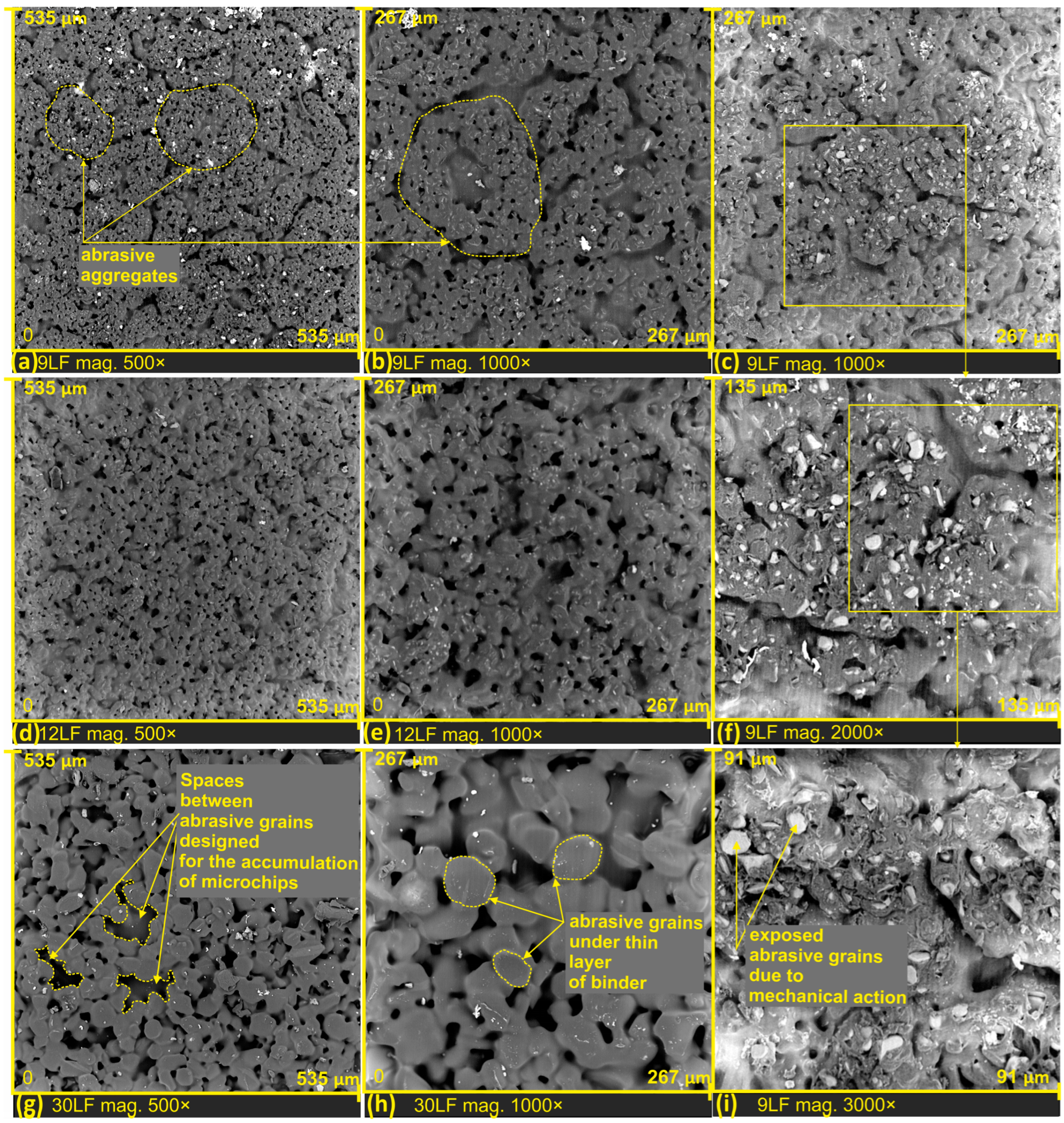
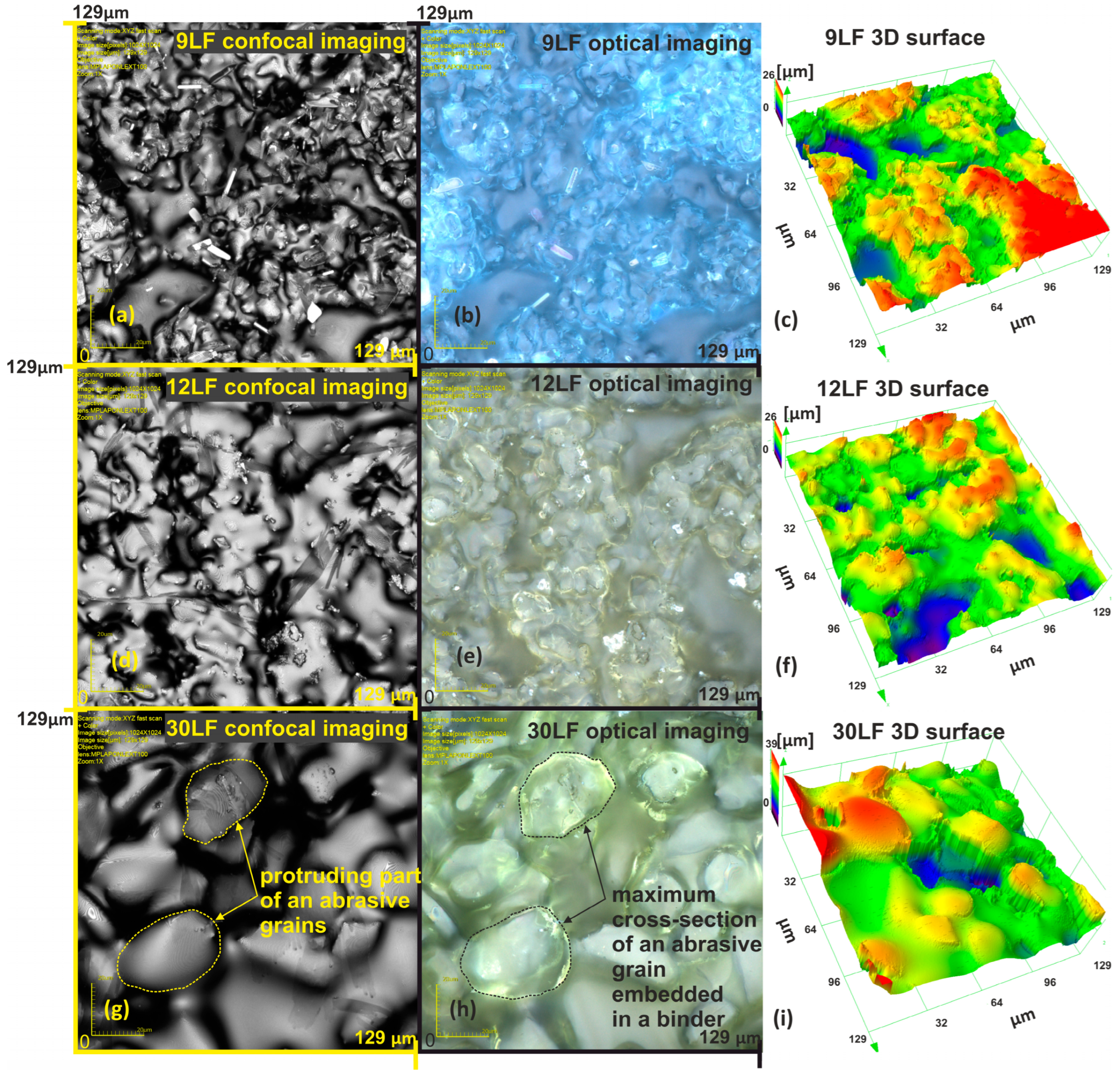
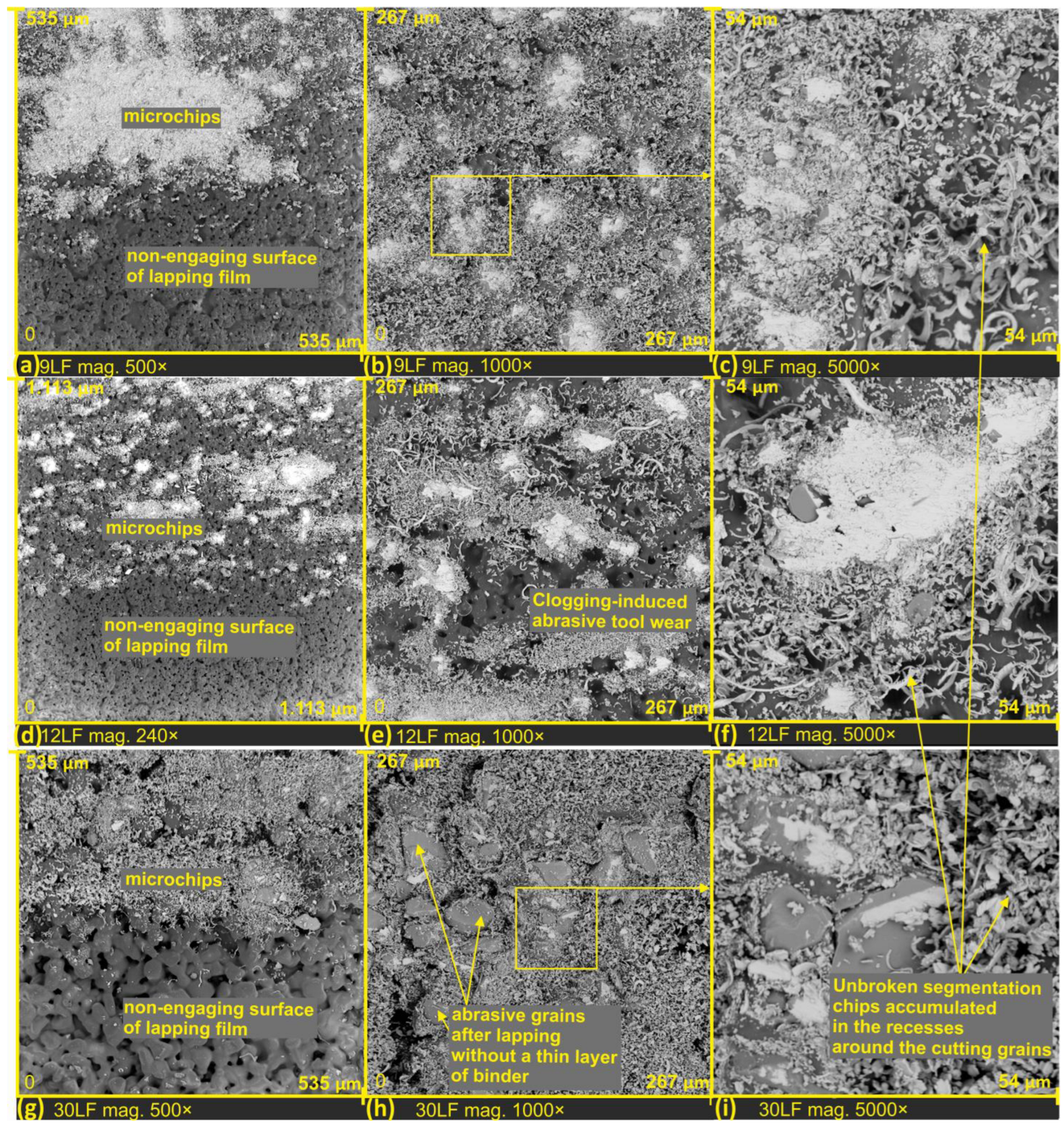

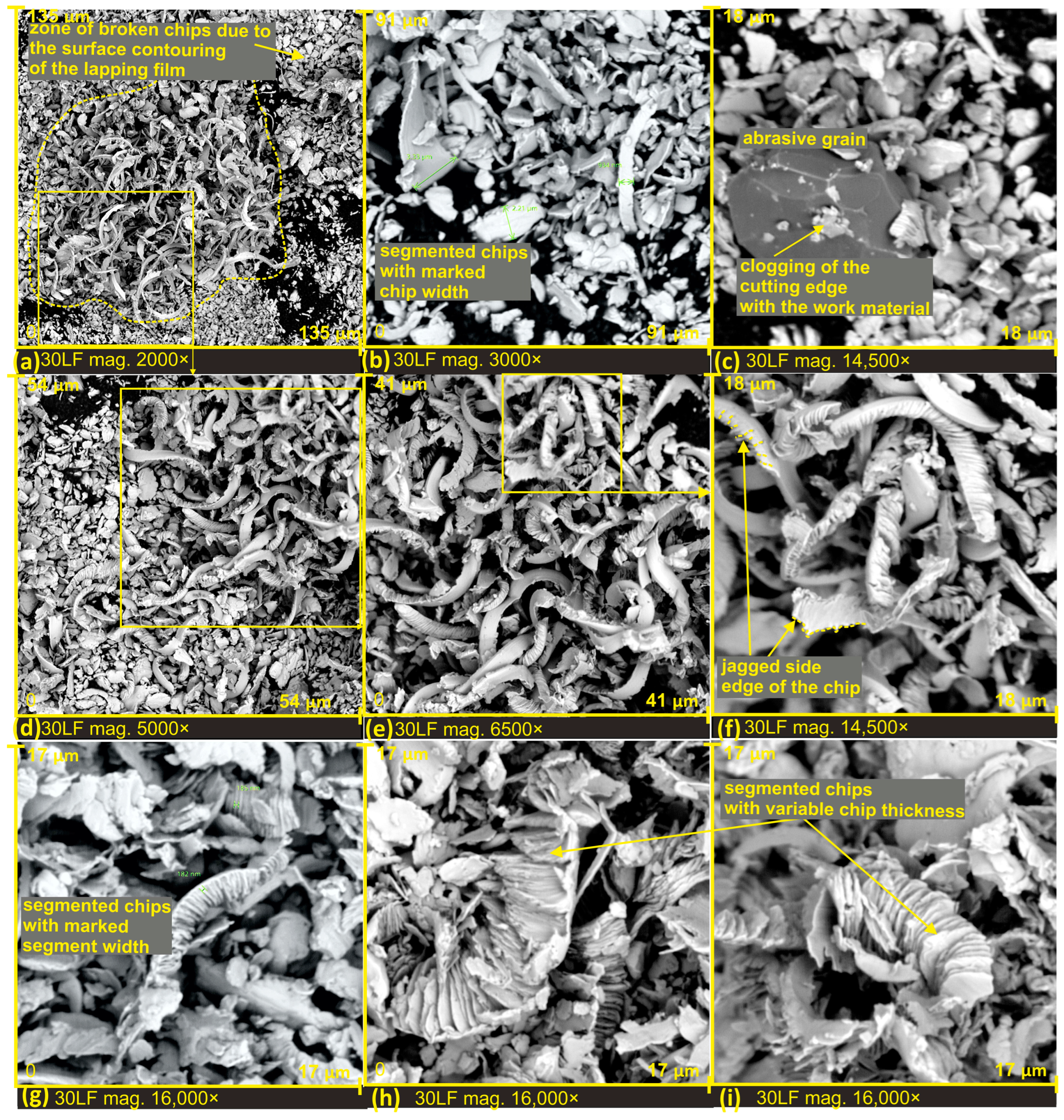
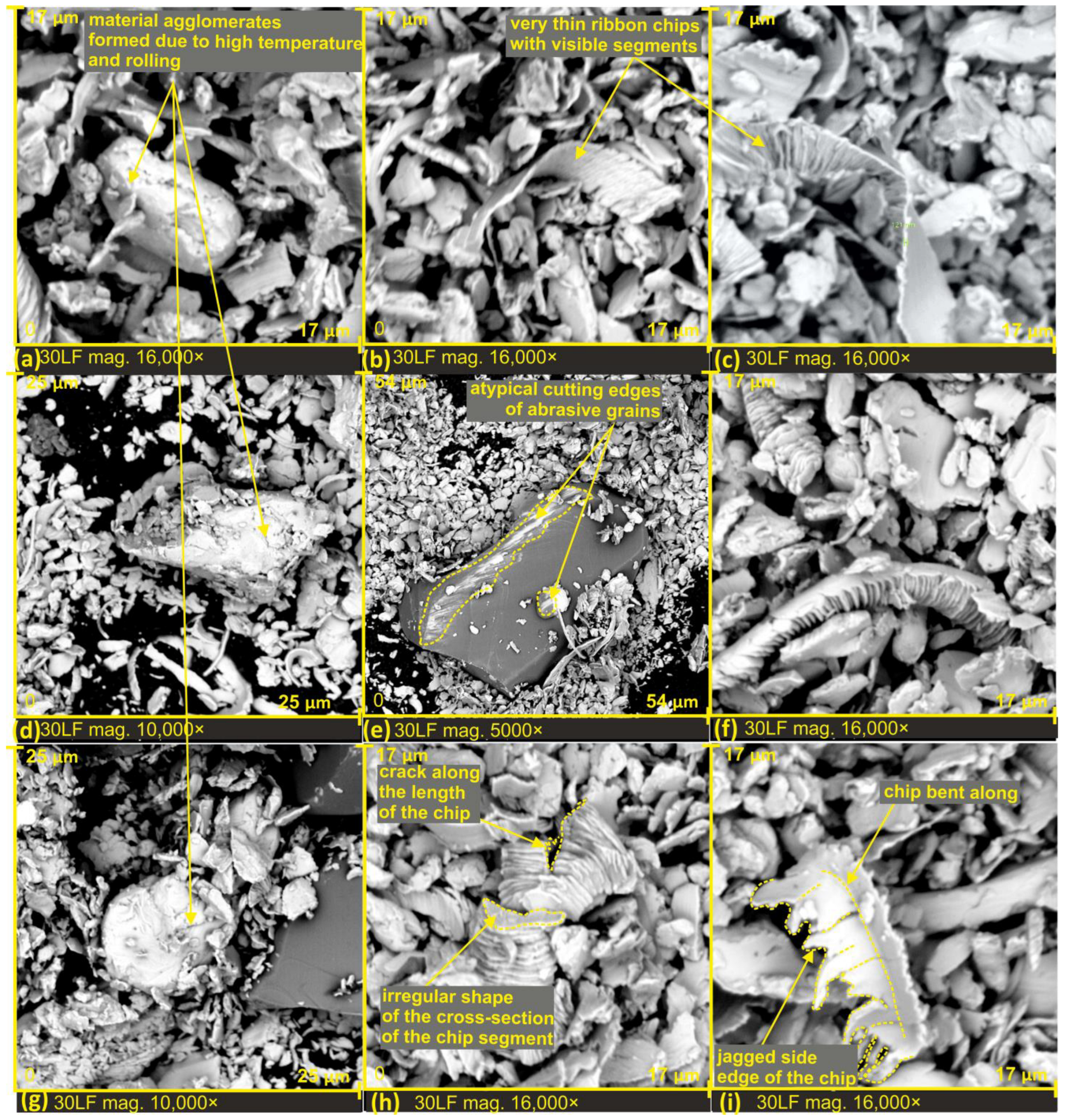
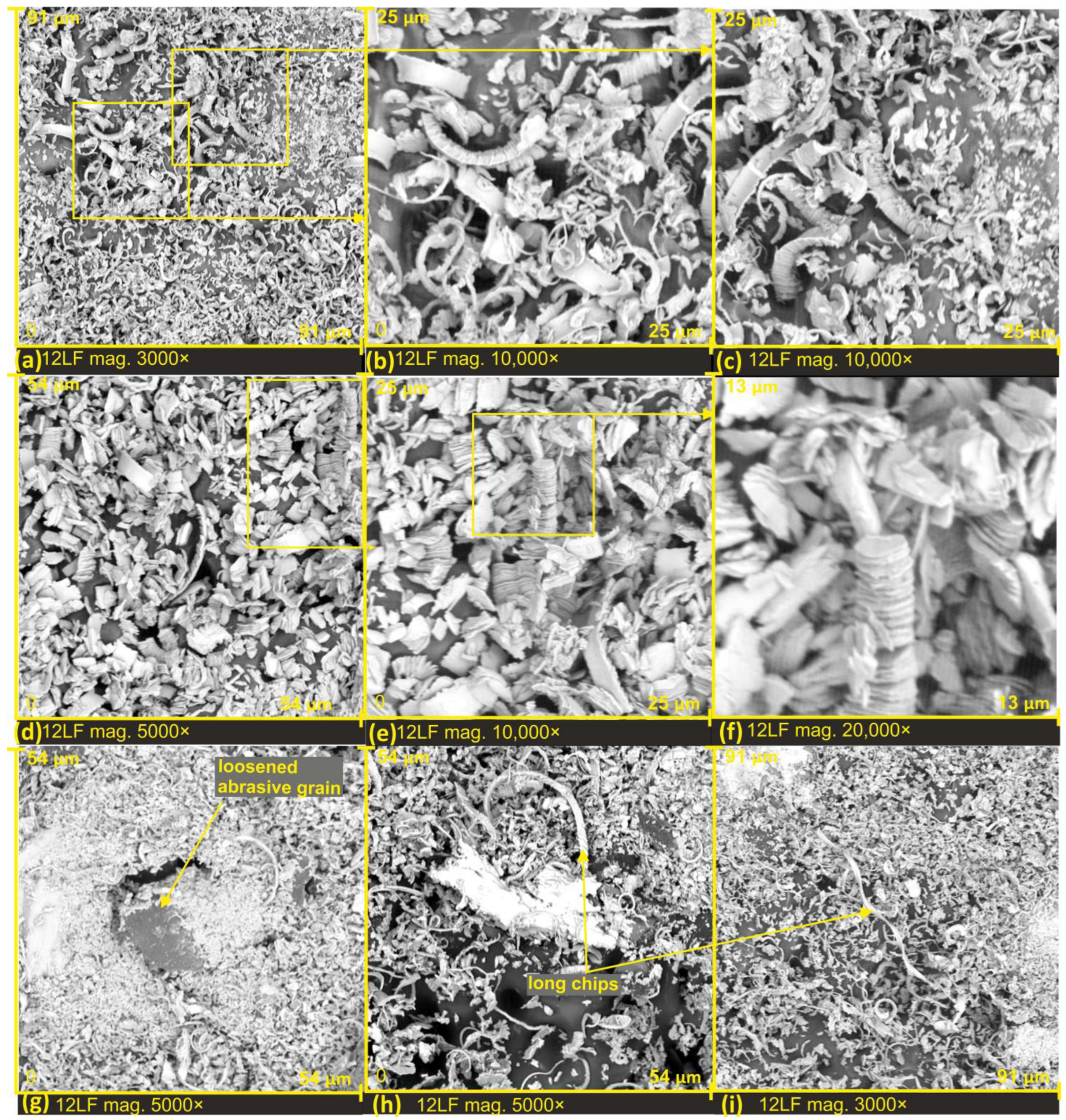

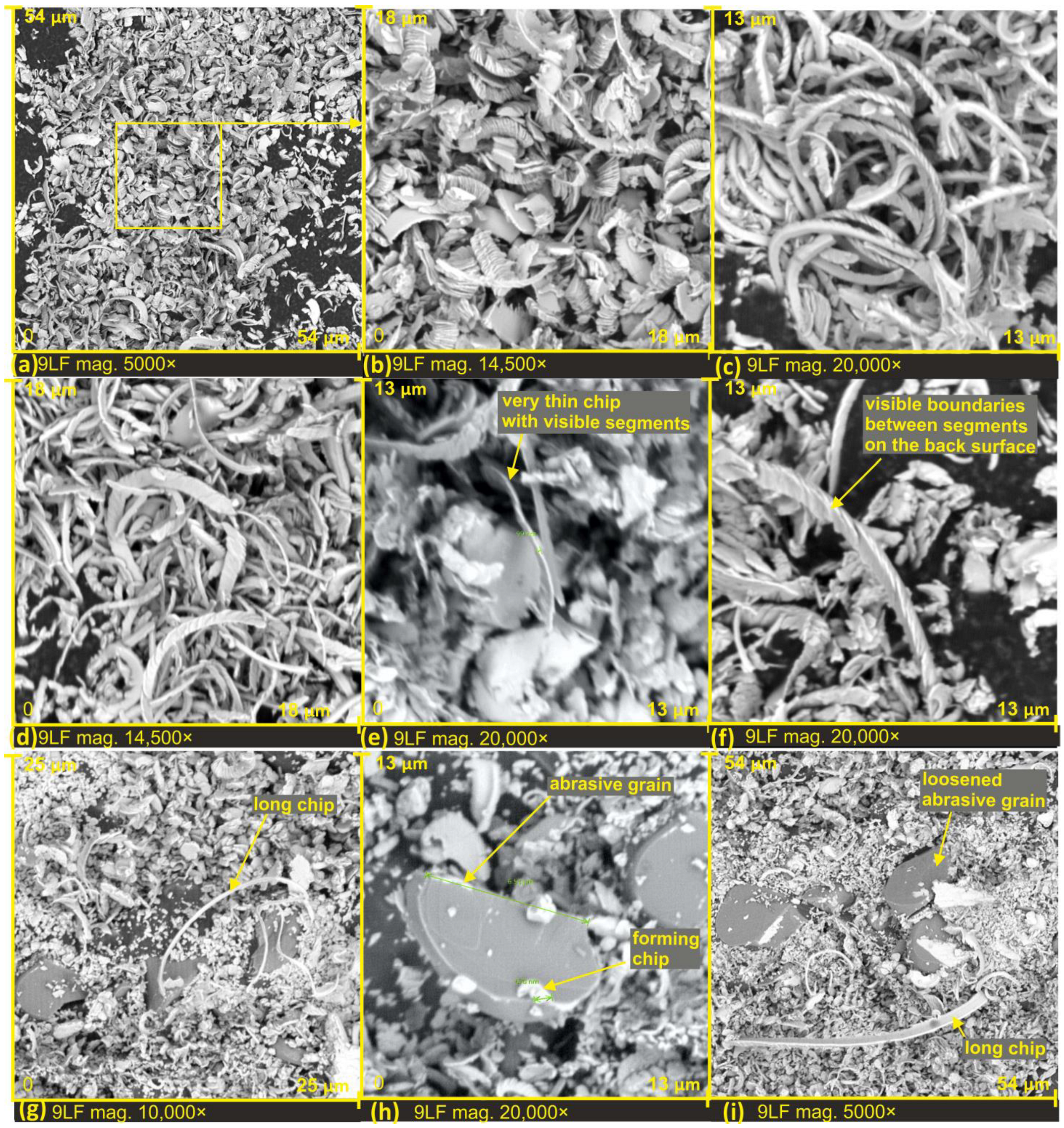

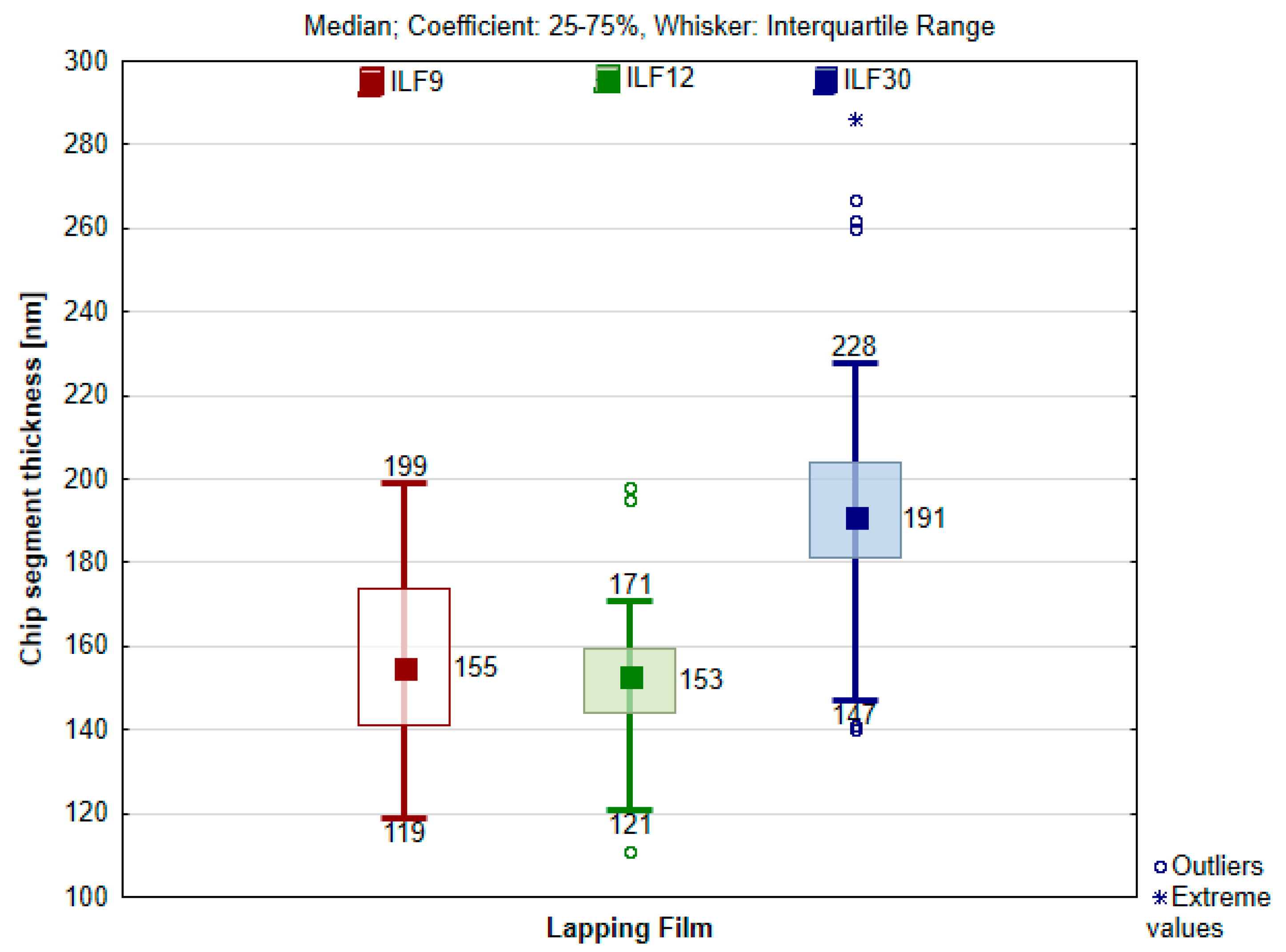
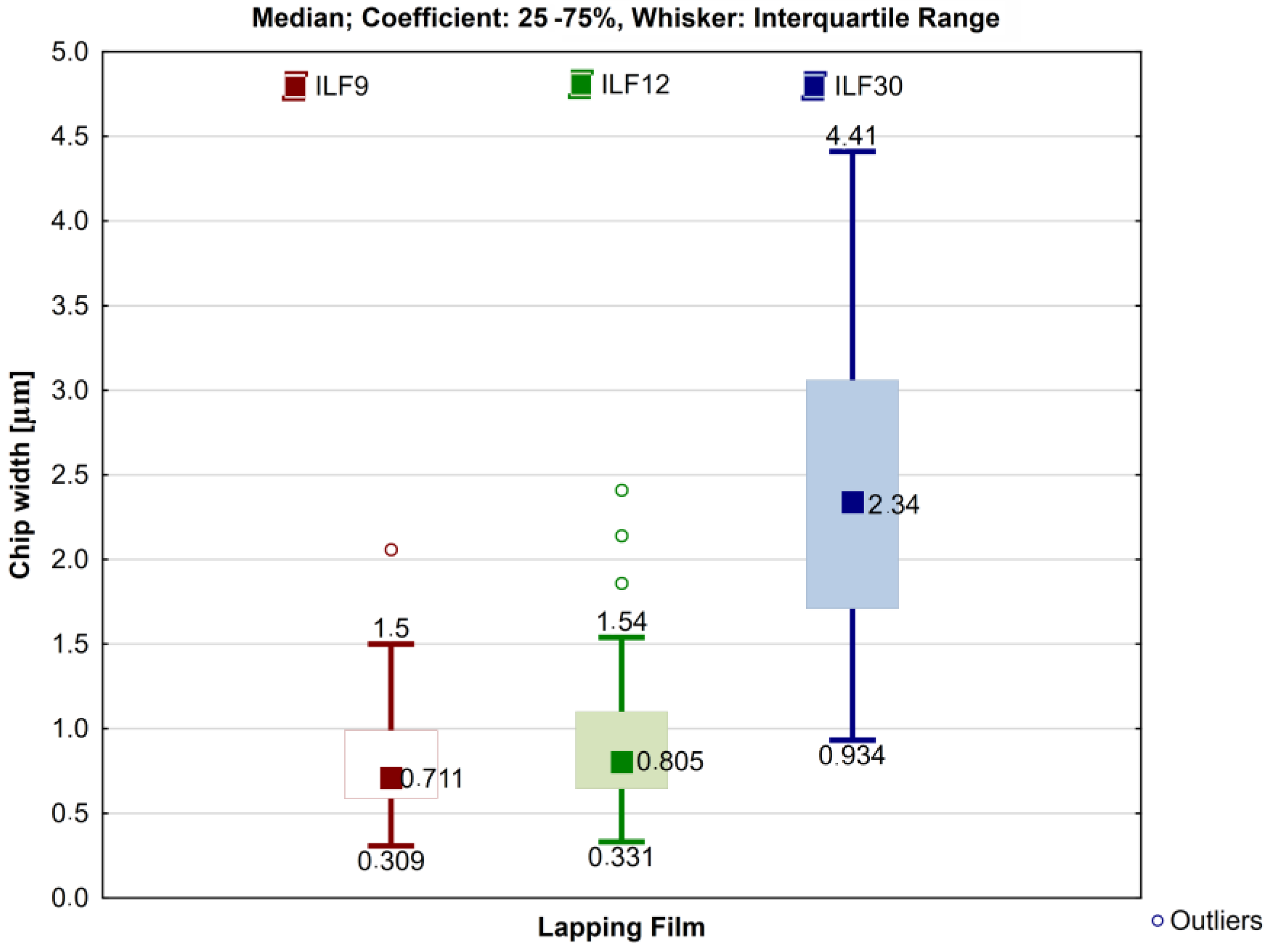
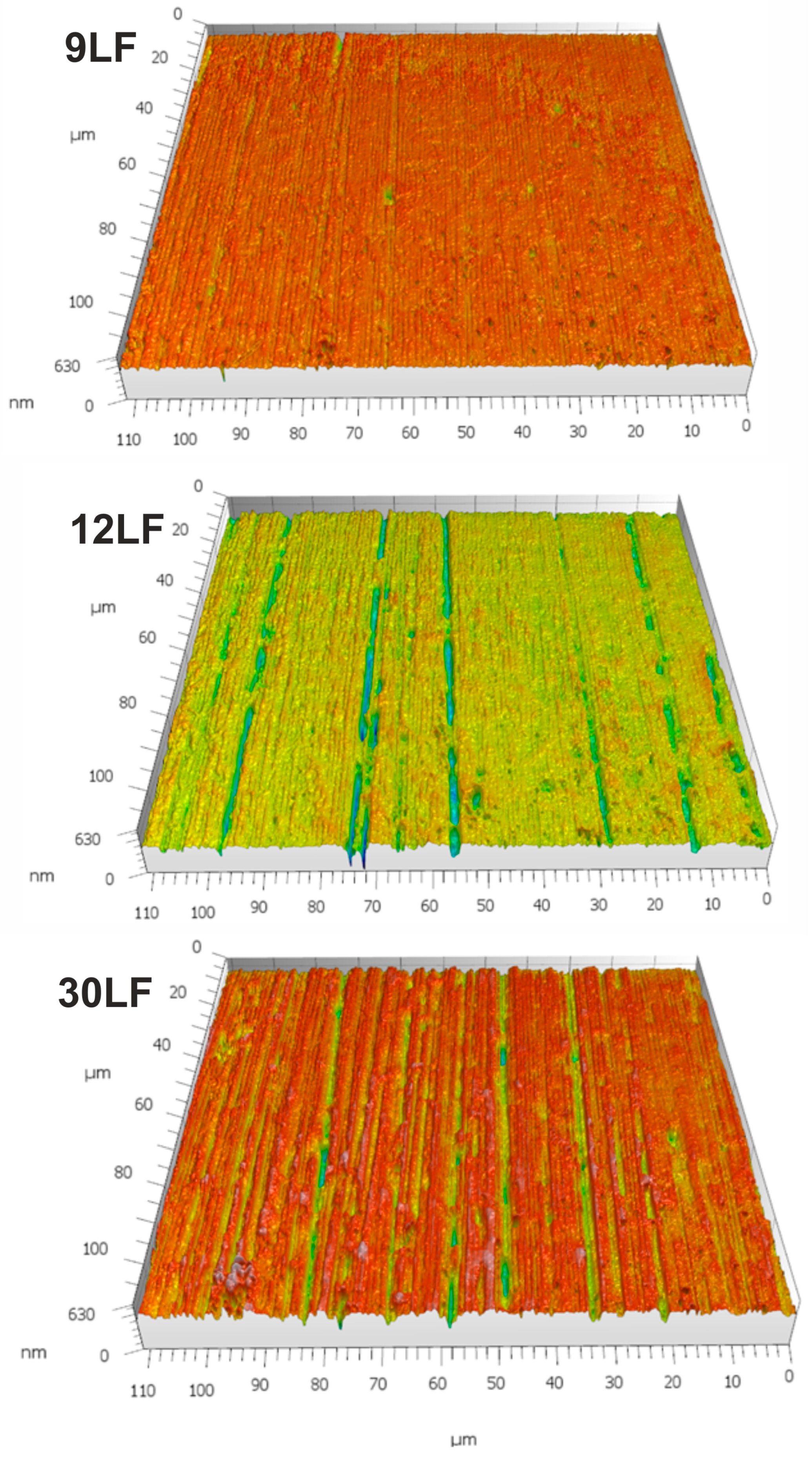
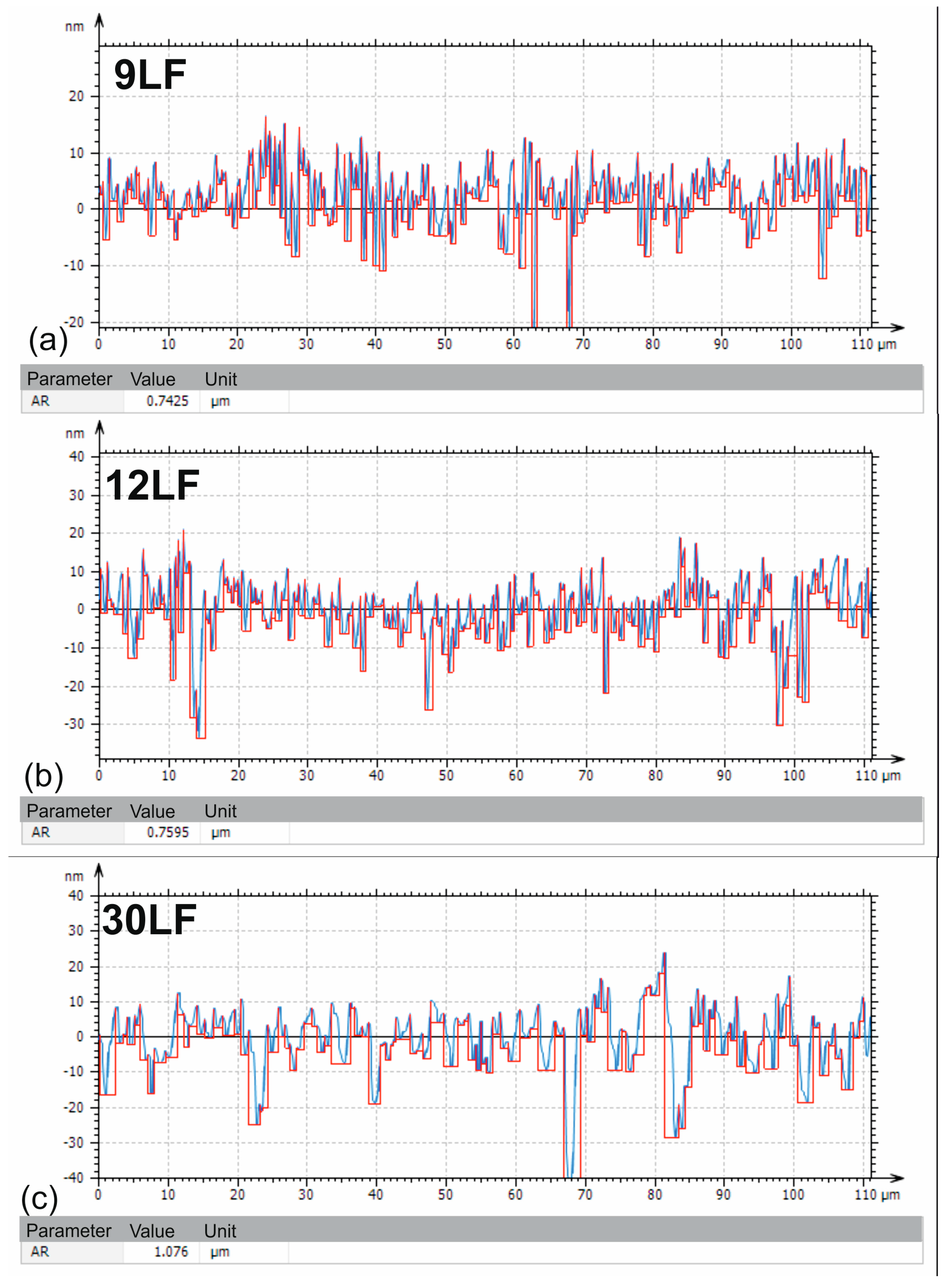
| Workpiece material | Tin Bronze Alloy (CuSn7Zn4Pb6/RG7) |
| Pressure roll hardness | 50°Sh |
| Pressure force | 50 N |
| Tool speed | 160 mm/min |
| Workpiece speed | 105 m/min |
| Oscillation frequency | 80 Hz |
| Chip Segment Thickness [nm] | ||||
|---|---|---|---|---|
| Lapping Film | Mean | Minimum | Maximum | Standard Deviation |
| LF9 | 156.54 | 119 | 199 | 22.69 |
| LF12 | 152.68 | 111 | 198 | 17.30 |
| LF30 | 197.65 | 140 | 286 | 36.81 |
| Chip Segmentation Frequency [MHz], the Frequency Determined within the Range of 5 to 15 Degrees of Tangential Grain Cutting Angle: | |
|---|---|
| Lapping Film | fs |
| LF9 | 0.975–2.893 |
| LF12 | 0.999–2.966 |
| LF30 | 0.772–2.291 |
| Chip Width [µm] | ||||
|---|---|---|---|---|
| Lapping Film | Mean | Minimum | Maximum | Standard Deviation |
| LF9 | 0.813 | 0.309 | 2.06 | 0.350 |
| LF12 | 0.889 | 0.331 | 2.41 | 0.441 |
| LF30 | 2.429 | 0.934 | 4.41 | 0.941 |
| Parameters for Assessing Surface Roughness [µm] | ||||
|---|---|---|---|---|
| Parameter [Unit] | Mean | Standard Deviation | Minimum | Maximum |
| LF9 | ||||
| Sp [µm] | 0.1071 | 0.03957 | 0.0660 | 0.1980 |
| Sv [µm] | 0.6714 | 0.1970 | 0.4311 | 0.9710 |
| Sz [µm] | 0.7785 | 0.2081 | 0.5117 | 1.084 |
| Sa [µm] | 0.01304 | 0.002492 | 0.01057 | 0.01967 |
| LF12 | ||||
| Sp [µm] | 0.126 | 0.014 | 0.092 | 0.149 |
| Sv [µm] | 0.565 | 0.131 | 0.360 | 0.818 |
| Sz [µm] | 0.692 | 0.137 | 0.482 | 0.967 |
| Sa [µm] | 0.020 | 0.003 | 0.016 | 0.024 |
| LF30 | ||||
| Sp [µm] | 0.1971 | 0.08096 | 0.1195 | 0.3965 |
| Sv [µm] | 0.7009 | 0.2127 | 0.3427 | 1.082 |
| Sz [µm] | 0.8980 | 0.2677 | 0.4626 | 1.406 |
| Sa [µm] | 0.02677 | 0.003374 | 0.02284 | 0.0337 |
| Parameter [Unit] | Mean | Standard Deviation | Minimum | Maximum |
|---|---|---|---|---|
| LF9 | ||||
| AR [µm] | 1.0001 | 0.1135 | 0.7425 | 1.17 |
| LF12 | ||||
| AR [µm] | 1.0832 | 0.1773 | 0.7595 | 1.214 |
| LF30 | ||||
| AR [µm] | 1.1898 | 0.0914 | 1.076 | 1.355 |
Disclaimer/Publisher’s Note: The statements, opinions and data contained in all publications are solely those of the individual author(s) and contributor(s) and not of MDPI and/or the editor(s). MDPI and/or the editor(s) disclaim responsibility for any injury to people or property resulting from any ideas, methods, instructions or products referred to in the content. |
© 2024 by the authors. Licensee MDPI, Basel, Switzerland. This article is an open access article distributed under the terms and conditions of the Creative Commons Attribution (CC BY) license (https://creativecommons.org/licenses/by/4.0/).
Share and Cite
Tandecka, K.; Kacalak, W.; Wiliński, M.; Wieczorowski, M.; Mathia, T.G. Morphology of Microchips in the Surface Finishing Process Utilizing Abrasive Films. Materials 2024, 17, 688. https://doi.org/10.3390/ma17030688
Tandecka K, Kacalak W, Wiliński M, Wieczorowski M, Mathia TG. Morphology of Microchips in the Surface Finishing Process Utilizing Abrasive Films. Materials. 2024; 17(3):688. https://doi.org/10.3390/ma17030688
Chicago/Turabian StyleTandecka, Katarzyna, Wojciech Kacalak, Maciej Wiliński, Michał Wieczorowski, and Thomas G. Mathia. 2024. "Morphology of Microchips in the Surface Finishing Process Utilizing Abrasive Films" Materials 17, no. 3: 688. https://doi.org/10.3390/ma17030688
APA StyleTandecka, K., Kacalak, W., Wiliński, M., Wieczorowski, M., & Mathia, T. G. (2024). Morphology of Microchips in the Surface Finishing Process Utilizing Abrasive Films. Materials, 17(3), 688. https://doi.org/10.3390/ma17030688










